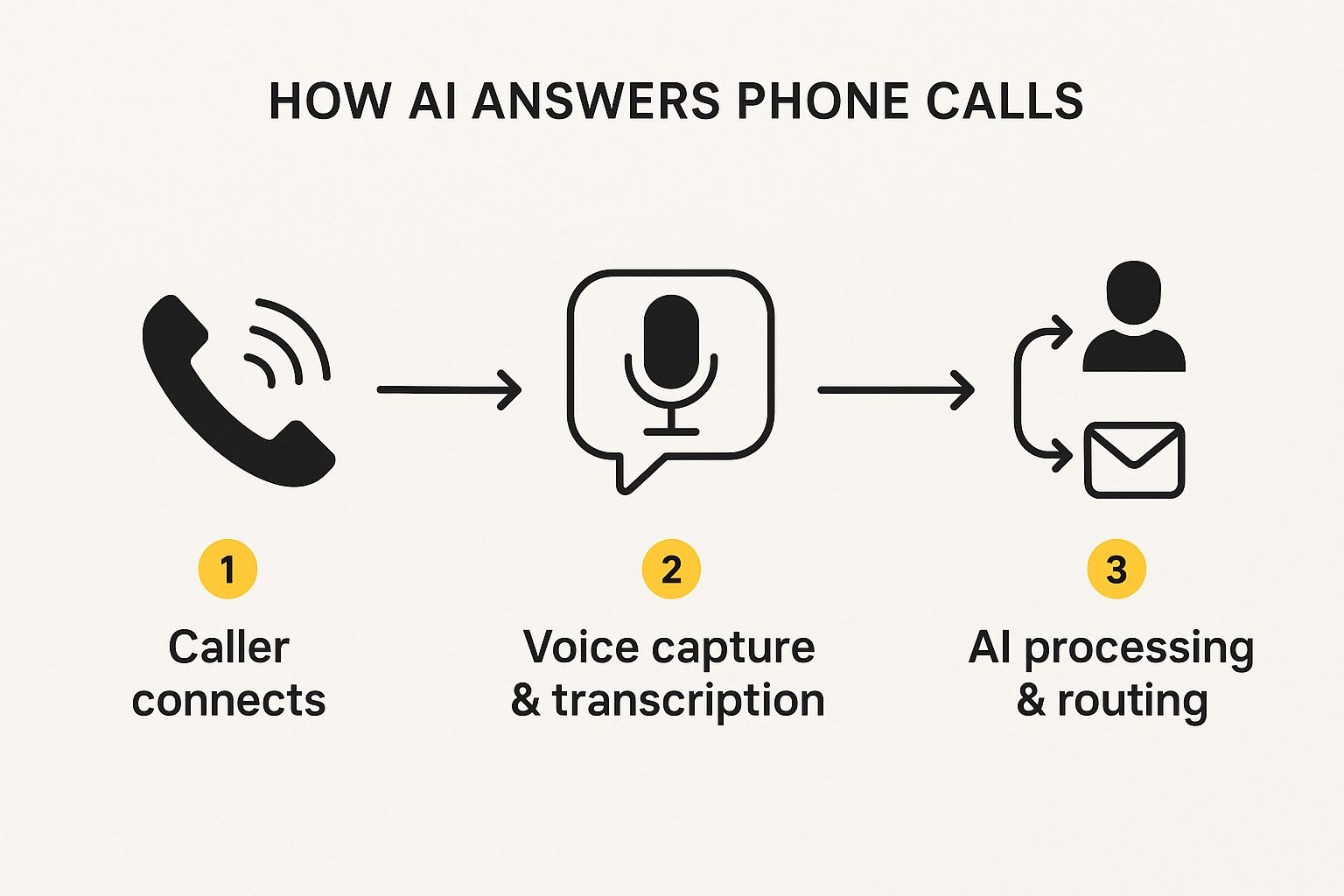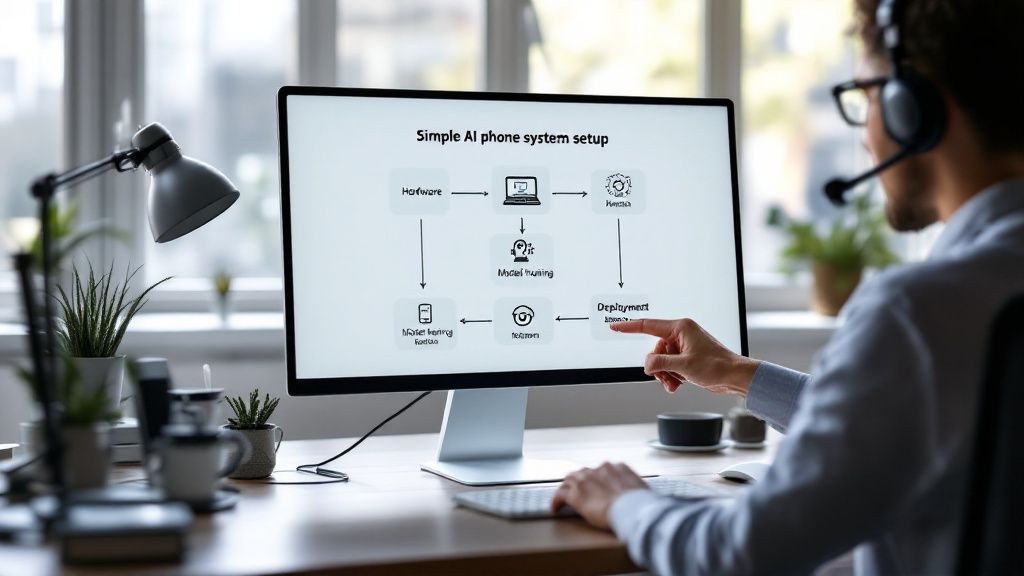Of course, AI can absolutely answer your phone calls, and it’s a world away from those clunky, robotic menus we all remember. Modern AI doesn't just follow a script; it engages in smart, dynamic conversations, completely changing the game for how businesses handle their front line.
So, How Does AI Phone Answering Actually Work?

Let's get one thing straight: forget those frustrating "press one for sales, press two for…" systems. Today's AI call assistants are built to understand, adapt, and respond just like a human receptionist would. The goal is to give your customers a seamless experience while taking a huge weight off your shoulders.
This technology has really taken off in Australia, where local businesses are finding their AI agents can handle surprisingly complex queries and hold a genuinely human-like conversation. We're talking about more than just taking a message. These systems can book appointments, figure out who to route a call to, and even flag urgent issues for the right person in real-time. If you're curious, you can learn more about how Aussie businesses are using AI voice assistants to shake things up.
What Can an AI Call Assistant Realistically Do?
So, what can you actually expect an AI to do for you? It's a lot more than a glorified voicemail. A modern AI call answering system is a powerful tool for your business's front line, armed with several key skills.
Here’s a quick look at what today's AI assistants bring to the table.
Key Capabilities of Modern AI Call Answering Systems
This table gives you a quick summary of what AI can realistically handle when answering phone calls for your business.
| Capability | What It Means for Your Business |
|---|---|
| 24/7 Call Answering | Your phone is always answered, even at 2 AM. You never miss a lead or an urgent customer call, no matter the time of day. |
| Intelligent Call Routing | The AI figures out what the caller needs and transfers them to the right person or department, all without you lifting a finger. |
| Appointment Scheduling | It connects to your calendar to book, reschedule, or cancel appointments based on your real-time availability. Simple. |
| Message Taking & Transcription | Every call is accurately transcribed and summarised, giving you clear, actionable notes you can read in seconds. |
Essentially, it's about putting the most time-consuming parts of phone management on autopilot so you can focus on the work that actually grows your business.
How AI Actually Understands and Responds to Callers
Ever wondered what’s really going on when an AI answers a call? It’s not magic, but it’s pretty clever. Think of it as a three-step dance that mimics a super-efficient human receptionist, allowing the AI to listen, understand, and reply in a way that feels surprisingly natural.
First up, the AI has to 'hear' what the caller is saying. It pulls this off using Speech-to-Text (STT) technology. Picture a lightning-fast stenographer instantly typing out every spoken word into text. This is the crucial first step, capturing the raw information before the real thinking begins.
Making Sense of the Conversation
Once the words are in text, the AI uses Natural Language Processing (NLP) to figure out the meaning and what the caller actually wants. This is the brains of the operation. NLP is what allows the system to pick up on keywords like "appointment," "quote," or "opening hours" and grasp the caller's goal, even if they're a bit vague.
This is where a modern voice AI agent really comes into its own, moving way beyond just matching keywords to understand the real flow of a conversation.
The AI doesn’t just hear words; it comprehends intent. This is the game-changer. It lets the system know if a caller wants to book a job, ask a question, or get put through to a specific person, paving the way for a genuinely helpful response.
Finally, after figuring out the request, the AI puts together a reply and uses Text-to-Speech (TTS) technology to 'speak' back. And no, we’re not talking about those clunky, robotic voices from the 90s. Today's advanced TTS engines create very human-like speech, complete with natural tones and pacing, making the whole chat a smooth and easy experience for the caller.
This image breaks down the whole process, from the moment a call connects to the final response.

As you can see, these three technologies—STT, NLP, and TTS—work together in a seamless loop to manage the entire call. It’s this coordinated dance that lets the AI handle conversations so effectively.
The Real-World Benefits for Your Business

Understanding the tech behind an AI answering calls is one thing, but seeing how it actually helps your bottom line is what really matters. For Aussie businesses, the advantages are practical, clear, and go way beyond simple convenience.
The most obvious benefit? You're always available.
Your business no longer needs to shut down at 5 PM. An AI is on the clock 24/7, making sure you capture every lead and help every customer, whether they call during their lunch break or late on a weekend. Missed opportunities quickly become a thing of the past.
Drastically Lowering Your Overheads
Beyond being available all the time, the numbers just make sense. Hiring, training, and keeping a full-time reception team is a huge expense—you've got salaries, benefits, and office space all adding up.
An automated phone answering system delivers the same quality of service, if not better, for a fraction of the cost.
By automating your frontline communications, you can shift thousands of dollars from overheads into things that actually grow your business, like marketing or developing new products. It’s not about replacing people; it's about using your resources where they’ll have the biggest impact.
This shift is already happening in a country that's more than comfortable with AI. Australia is actually leading the world in AI search interactions, with over 38 million AI-powered searches logged in late 2024. As businesses see this trend, they're getting more and more confident bringing AI into customer-facing roles.
Scaling Your Service Without the Headaches
Another massive win is scalability. A human receptionist can only handle one call at a time. When you get a sudden rush of enquiries, calls get missed, and potential customers just move on to your competitor. It's a classic bottleneck.
An AI, on the other hand, can handle one call or one hundred calls at the exact same time, with zero drop in service quality. This ability to scale up instantly gives you a level of flexibility that's just impossible for a human team to match.
Every single caller gets the same professional and prompt interaction, every single time.
Right, let's get into how AI is actually helping Aussie businesses handle their phones day in, day out. The theory is one thing, but seeing it solve real problems is where it gets interesting. This isn't some futuristic tech anymore; it's a practical tool that tradies, clinics, and online retailers are using to make life easier.
AI Answering Calls in Action Across Australia
Picture a plumber in Melbourne, stuck on a tricky job. In the old days, every time the phone rang, he’d have to choose: either down tools and answer, or ignore it and possibly lose a new customer to the next person on Google. It’s a classic headache.
Now, imagine an AI assistant taking those calls. It can give instant quotes for standard jobs, check the plumber's schedule, and slot new bookings straight into his calendar. The plumber keeps working, and the new jobs just keep rolling in. Simple as that.
From Tradies to Medical Practices
It's the same story for a busy medical clinic in Sydney. The front desk is often flat out, with phones ringing off the hook. By getting an AI to handle appointment scheduling, cancellations, and reminders, they’ve completely changed the game.
This one change frees up the reception staff to actually focus on the patients standing right in front of them. It creates a much calmer, more organised environment for everyone. The AI just chugs away in the background, handling all the routine stuff with perfect accuracy.
The real win here is pretty straightforward: the AI takes care of the repetitive, time-sucking calls so your skilled people can focus on the work that actually matters. It's about making your whole workflow smarter, not just answering the phone.
Then you've got a small e-commerce store based out of Brisbane, constantly getting hit with "Where's my order?" calls. Instead of having a staff member spend their day looking up tracking numbers, their AI is plugged into their system and gives customers instant, accurate updates 24/7. Customer satisfaction goes up, and the support team's workload drops.
These examples really show how flexible AI phone calls can be. It doesn't matter if you're capturing leads, booking appointments, or providing customer support—the tech just works, slotting right into your daily operations and making a real difference.
Understanding the Risks and Limitations of AI

While the benefits of AI are pretty clear, it's just as important to have a balanced view. Let's be honest, no technology is a silver bullet for every problem. Understanding where AI answering calls might fall short is the key to using it effectively and, more importantly, safely.
One of the biggest things to keep in mind is security. As AI becomes more common, it naturally becomes a target for new kinds of threats. This means strong security measures aren't just a 'nice-to-have'—they're absolutely essential to protect your business and your customers' data.
This brings us to a growing issue here in Australia known as 'vishing,' or voice phishing. Hackers are now using AI to create incredibly convincing voice clones to impersonate staff or other trusted people. They’re tricking folks into bypassing normal security checks, exploiting human trust by manipulating conversations in real-time. It really highlights the serious cybersecurity challenges businesses now face. You can learn more about how AI is shaping Australia's cybersecurity landscape on latitudeit.com.au.
Knowing When a Human Is Still Needed
Beyond the security side of things, there are also practical limits to what today's AI can handle. The technology has made huge leaps, no doubt, but it still struggles with conversations that are highly nuanced, complex, or emotionally charged.
Think about a caller who is extremely upset, confused, or trying to explain a really unusual problem. These situations often demand empathy, creative problem-solving, and a level of understanding that AI just isn't equipped to provide yet.
A well-designed AI system knows its own limits. Its job isn't just to answer calls but also to recognise when a conversation needs the warmth and intuition of a real person, ensuring a smooth handoff to a human team member without causing frustration.
Ultimately, the goal is to see AI as a powerful tool, not a complete replacement for human interaction. It's all about knowing when it’s the perfect choice for the job and when a call really needs to be passed on to a person.
Of course. Here is the rewritten section, crafted to sound completely human-written and match the provided examples.
Got Questions About AI Answering Calls? You're Not Alone.
So, the idea of an AI answering your calls sounds pretty good, right? It can definitely bring some serious perks to your business. But before jumping in headfirst, it’s smart to have a few practical questions. Let's run through some of the most common things business owners ask when they’re thinking about getting started.
My goal here is to clear up any confusion and help you figure out if this kind of tech is actually a good fit for how you run things.
How Long Does It Really Take to Get Set Up?
This is a big one, but it’s often a lot quicker than people think. For a pretty standard setup, most businesses can be up and running within a few weeks. You’re typically looking at around 3 to 5 weeks to get everything dialled in and working smoothly.
That initial time is all about teaching the AI the ropes of your business – things like what you do, when you're open, how you price things, and the usual questions customers throw at you. If you need something a bit more complex, like hooking it directly into your CRM or a specialised booking system, it might take a little longer to make sure it all talks to each other properly.
Will It Sound Like a Robot to My Customers?
I get it. Nobody wants their customers greeted by a clunky, robotic voice. But thankfully, we've come a long, long way from the early days of automated voices. Modern text-to-speech tech is incredibly sophisticated now, creating voices that sound natural, with proper pacing and tone. You can even pick different accents to suit your brand.
Sure, some very basic, cheap systems might still sound a bit mechanical. But any professional-grade service puts a massive emphasis on creating a warm, conversational feel. The whole point is to make it feel like your customer is talking to a sharp, well-trained human receptionist, so they feel looked after right from the get-go.
A quality AI call system is designed so that for most everyday chats, you can't even tell it's not a person. It’s all about the customer experience, not just ticking a box for automation. A friendly, natural tone is non-negotiable.
What Happens if the AI Gets Stumped on a Question?
A good AI knows what it doesn't know – and that's one of its most important features. When it comes up against a question it can't handle, a really tricky or emotional caller, or someone who just flat-out asks for a human, it's built to pass the call on without a fuss.
This handover can work in a few different ways:
- Live Transfer: The AI can put the caller straight through to you or one of your team.
- Taking a Message: It’ll take down all the details and let the caller know a real person will get back to them ASAP.
- Instant Alert: The system can fire off an immediate email or text to your team with the call details and a full transcript of what was said.
This built-in safety net means no customer ever gets left hanging, and every single query gets sorted by the right person.
Ready to see how an AI call assistant can give you back hours every week? OnSilent provides a smart, seamless solution that filters spam, organises your calls, and ensures you never miss an important opportunity. Learn more about how OnSilent can help and discover a smarter way to manage your calls.

